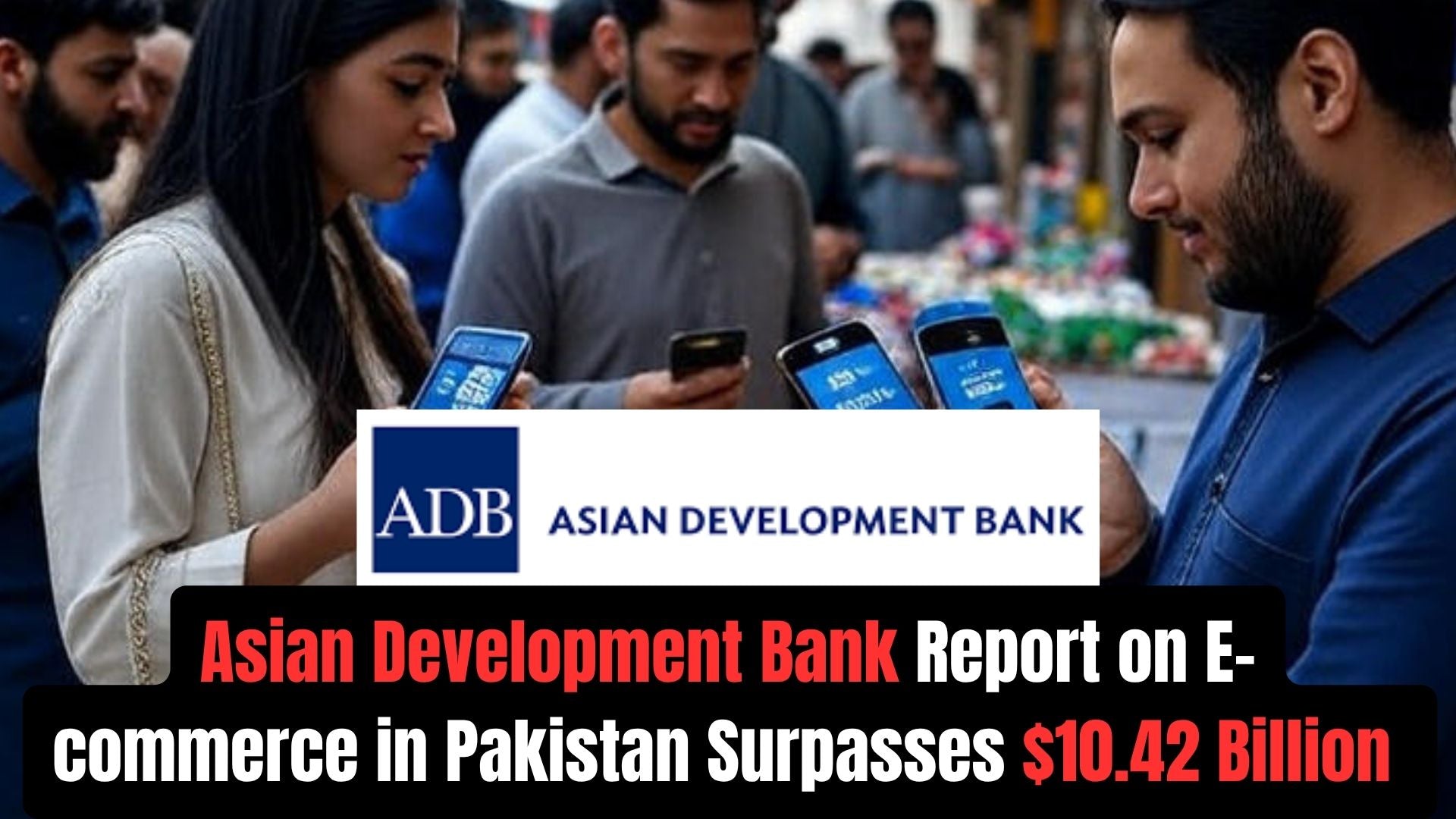Asian Development Banks Report on Ecommerce In Pakistan Surpasses $10.42 Billion

Pakistan’s E-Commerce Boom: Unlocking a $10.42 Billion Market in 2025
Pakistan’s e-commerce sector is experiencing a digital revolution, reaching a staggering $10.42 billion in 2025, according to the Asian Development Bank’s (ADB) Pakistan’s Digital Ecosystem: A Diagnostic Report (July 2025). With projections estimating growth to $12 billion by 2027 at a 17% CAGR, Pakistan is poised to become a key player in the global digital economy. But what’s driving this boom, and what challenges must be addressed to sustain it? This article dives into the ADB’s findings, unpacking the opportunities, hurdles, and strategies for businesses, SMEs, and women entrepreneurs to thrive in Pakistan’s e-commerce landscape.

A Thriving E-Commerce Market
The ADB report highlights Pakistan’s e-commerce market as a powerhouse, fueled by increasing smartphone adoption and digital awareness. In 2024, the market was valued at $7.7 billion, with retail e-commerce contributing $5.4 billion, led by electronics (24% of revenue), fashion, beauty products, and luxury items. The 427% growth in registered e-commerce merchants and 457% surge in e-commerce volume from 2019 to 2023 underscore the sector’s rapid expansion. By 2027, the market is expected to hit $12 billion, aligning with the government’s E-Commerce Policy 2025–30, which aims to boost exports to $60 billion by 2028.
Key Stat: 80% of e-commerce shoppers in Pakistan use mobile devices, reflecting the dominance of mobile commerce in urban and semi-urban areas.
Digital Infrastructure: The Foundation and the Challenge
While the growth is impressive, the ADB report flags critical infrastructure gaps that hinder Pakistan’s e-commerce potential:
-
Low Broadband Access: Only 1.3% of the population has fixed broadband, limiting access for rural entrepreneurs and consumers.
-
Poor Internet Speeds: Pakistan ranks 97th globally in mobile internet speed, impacting website load times, product uploads, and checkout processes.
-
Urban-Rural Divide: Rural areas face connectivity bottlenecks, restricting SMEs’ ability to scale online.
These challenges slow the digital economy’s contribution, which accounts for just 1.5% of Pakistan’s GDP, compared to regional leaders like India and Bangladesh. The ADB recommends heavy investment in broadband expansion and reliable 4G/5G networks to bridge this gap, a priority echoed in the E-Commerce Policy 2025–30.
Actionable Tip: Optimize your Shopify store for mobile users with fast-loading pages and lightweight designs to cater to Pakistan’s 80% mobile shoppers, even on slower networks.

Consumer Behavior and Payment Trends
Pakistan’s e-commerce shoppers exhibit unique behaviors shaped by trust and payment preferences:
-
Cash on Delivery (COD) Dominance: A staggering 93.7% of e-commerce transactions rely on COD, reflecting skepticism about online payments due to fraud concerns and high-profile cases of undelivered products.
-
Digital Payment Growth: Despite COD’s prevalence, 84% of in-store payments in 2024 were mobile-based, and over 60% of Pakistanis are now banked, signaling a shift toward digital wallets like JazzCash and Easypaisa.
-
Mobile-Driven Shopping: With 80% of shoppers using smartphones, mobile-optimized platforms like Daraz and Shopify stores are critical for capturing urban consumers.
The ADB emphasizes that building consumer trust through secure payment gateways and transparent return policies is essential to reduce COD reliance and boost online spending.
Actionable Tip: Offer 5% discounts for digital payments (e.g., JazzCash, Easypaisa) on your Shopify store using apps like PioPay to incentivize digital adoption and align with policy goals.
Regulatory and Structural Challenges
The ADB report identifies outdated regulations as a major barrier to e-commerce growth:
-
Weak Consumer Protection: Lack of robust laws for online transactions erodes trust, deterring first-time buyers.
-
Complex Taxation: High tax burdens and inconsistent policies discourage foreign investment and burden SMEs. The ADB proposes a uniform 5% GST on digital transactions to simplify compliance and attract global players.
-
Logistics Bottlenecks: Costly last-mile delivery services increase consumer prices, reducing competitiveness compared to regional peers like India.
The report calls for updated policies, e-courts for dispute resolution, and streamlined taxation to create a business-friendly environment, aligning with the Ministry of Commerce’s ongoing consultations for the E-Commerce Policy 2025–30.
Actionable Tip: Partner with local logistics providers like TCS or Leopard Courier and negotiate bulk rates to reduce delivery costs, making your products more affordable.

Opportunities for SMEs and Women Entrepreneurs
E-commerce is a game-changer for Pakistan’s SMEs and women entrepreneurs, but access barriers persist:
-
SME Growth: SMEs face challenges like limited digital marketing skills and tools, especially outside urban centers. The ADB suggests government-backed training programs to help SMEs digitize and compete globally.
-
Women’s Empowerment: Only 23% of women participate in Pakistan’s labor force, but e-commerce platforms enable women to start businesses from home. However, access to affordable devices and internet remains a hurdle.
-
Export Potential: Platforms like Alibaba and Amazon offer SMEs access to global markets, supporting the government’s $60 billion export target by 2028.
The ADB recommends targeted initiatives, such as digital literacy workshops and subsidies for rural internet access, to empower SMEs and women, aligning with the National Gender Policy Framework 2022.
Actionable Tip: Join platforms like Daraz or Alibaba to reach nationwide and global markets, and leverage free digital marketing tools like Canva for social media promotions.
Policy Recommendations for a Digital Future
The ADB outlines actionable steps to unlock Pakistan’s e-commerce potential:
-
Invest in Infrastructure: Expand broadband and 4G/5G coverage, especially in rural areas, to support SMEs and consumers.
-
Strengthen Regulations: Introduce consumer protection laws and e-courts to resolve online disputes, boosting trust.
-
Promote Digital Payments: Encourage secure payment gateways to reduce COD reliance, as seen in regional success stories like India’s UPI.
-
Support SMEs: Offer digital marketing workshops and affordable logistics solutions to help SMEs scale.
-
Simplify Taxation: Implement a 5% GST on digital transactions to attract investment and streamline compliance.
These recommendations align with the Ministry of Commerce’s E-Commerce Policy 2025–30, which aims to modernize Pakistan’s digital economy and achieve a $12 billion e-commerce market by 2027.
Seize the $10.42 Billion Opportunity
Pakistan’s e-commerce sector, valued at $10.42 billion in 2025, is a goldmine for businesses, SMEs, and women entrepreneurs. With 80% mobile shoppers, 93.7% COD usage, and a projected $12 billion market by 2027, the potential is immense—but so are the challenges. By addressing infrastructure gaps, building consumer trust, and embracing digital payments, Pakistan can rival regional leaders like India and Bangladesh. For Shopify merchants, optimizing for mobile, offering digital payment discounts, and leveraging platforms like Daraz can unlock this growth. As the ADB report emphasizes, strategic reforms and investments will transform Pakistan’s digital economy into a cornerstone of sustainable growth.
Sources: Asian Development Bank, Pakistan’s Digital Ecosystem: A Diagnostic Report (July 2025); PCMI E-Commerce Data Library; ECDB.com; Profit by Pakistan Today.






